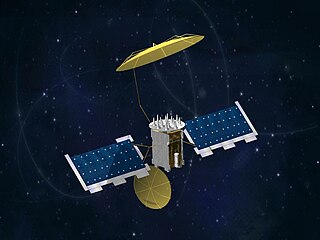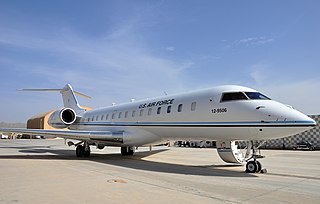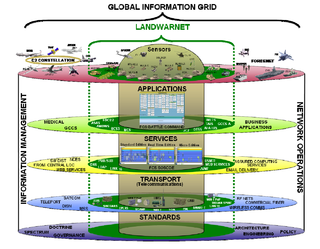
The Defense Information Systems Agency (DISA), known as the Defense Communications Agency (DCA) until 1991, is a United States Department of Defense (DoD) combat support agency composed of military, federal civilians, and contractors. DISA provides information technology (IT) and communications support to the President, Vice President, Secretary of Defense, the military services, the combatant commands, and any individual or system contributing to the defense of the United States.
The Medium Extended Air Defense System (MEADS) is a ground-mobile air and missile defense system intended to replace the Patriot missile system through a NATO-managed development. The program is a development of the United States, Germany and Italy.

The Joint Tactical Radio System (JTRS) aimed to replace existing radios in the American military with a single set of software-defined radios that could have new frequencies and modes (“waveforms”) added via upload, instead of requiring multiple radio types in ground vehicles, and using circuit board swaps in order to upgrade. JTRS has seen cost overruns and full program restructurings, along with cancellation of some parts of the program.
The small extension node (SEN) is part of a US military communication system known as Mobile Subscriber Equipment (MSE). A SEN is composed of two shelters, a switching shelter and a Line of sight radio terminal shelter(LOS).

The Combat Capabilities Development Command (CCDC) C5ISR Center, formerly the Communications-Electronics RD&E Center (CERDEC), is the United States Army information technologies and integrated systems center. CCDC C5ISR Center is headquartered at Aberdeen Proving Ground in Maryland, with activities at Fort Belvoir in Virginia and Joint Base McGuire-Dix-Lakehurst in New Jersey.

The Mobile User Objective System (MUOS) is a United States Space Force narrowband military communications satellite system that supports a worldwide, multi-service population of users in the ultra high frequency (UHF) band. The system provides increased communications capabilities to newer, smaller terminals while still supporting interoperability with legacy terminals. MUOS is designed to support users who require greater mobility, higher bit rates and improved operational availability. The MUOS was declared fully operational for use in 2019.
The Defense Information System Network (DISN) has been the United States Department of Defense's enterprise telecommunications network for providing data, video, and voice services for 40 years.

The 11th Corps Signal Brigade of the United States Army is an element of Army Forces Command. It is based at Fort Cavazos, Texas. The unit mascot is the Thunderbird, a hawk-like bird perched upon a globe shooting thunderbolts out of its eyes. Soldiers in this unit call themselves "The Thunderbirds."

The Battlefield Airborne Communications Node (BACN) is a United States Air Force (USAF) airborne communications relay and gateway system carried by the unmanned EQ-4B and the manned Bombardier E-11A aircraft. BACN enables real-time information flow across the battlespace between similar and dissimilar tactical data link and voice systems through relay, bridging, and data translation in line-of-sight and beyond-line-of-sight situations. Its ability to translate between dissimilar communications systems allows them to interoperate without modification.
LandWarNet (LWN) is the United States Army’s contribution to the Global Information Grid (GIG) that consists of all globally interconnected, end-to-end set of Army information capabilities, associated processes, and personnel for collecting, processing, storing, disseminating, and managing information on demand supporting warfighters, policy makers, and support personnel. It includes all Army and leveraged Department of Defense (DOD)/Joint communications and computing systems and services, software, data security services, and other associated services. LandWarNet exists to enable the warfighter through Mission Command, previously described as Battle Command. Other U.S. service equivalent efforts to LandWarNet include the Navy's "FORCEnet" and the Air Force's "C2 Constellation."

The FCS Network - Brigade Combat Team (BCT) Network consists of five layers that deliver data to forward-deployed Army units.

The Military Satellite Communications Directorate is a United States Space Force organization headquartered at Los Angeles Air Force Base, California. It is one of several wings and other units that make up the Space and Missile Systems Center (SMC).

The Project Manager Force Battle Command Brigade and Below is a component of the Program Executive Office Command Control and Communications Tactical Special Projects Office in the United States Army. The phrase "brigade and below" in the name refers to the fact that operations and communications within these smaller Army units are shifting to a digital integration.
General Dynamics Mission Systems is a business unit of American defense and aerospace company General Dynamics. General Dynamics Mission Systems integrates secure communication and information systems and technology. General Dynamics Mission Systems has core manufacturing in secure communications networks; radios and satellite technology for the defense, cyber, public safety, and intelligence communities.
Air Warrior (AW) is a modular, integrated, rapidly reconfigurable combat aircrew ensemble designed for U.S. Army aircrews. Previous aviation life support equipment consisted of a non-integrated assemblage of protective and survival gear. AW uses a systems approach to equipping the aircrew and closes the capability gap between human and machine. Fielded incrementally in blocks to rapidly provide enhanced capabilities to the warfighter, AW leverages and integrates clothing and equipment, such as the Army Aircrew Combat Uniform and ballistic protection, from other product managers. As of April 2010, more than 18,000 AW systems had been fielded in support of Operation Iraqi Freedom and Operation Enduring Freedom.

The 86th Signal Battalion ("Tigers") of the United States Army is an element of 11th Signal Brigade. It is based at Fort Bliss, Texas. The unit mascot is the Tiger.

The Mobile Subscriber Equipment (MSE) system was tactical communication system created by GTE Government Systems for the United States Army. Acquisition began in 1985 for echelons below Corps and down to the battalion level. The system was first fielded in February 1988 to the 13th Signal Battalion, 1st Cavalry Division at Fort Hood, Texas.

The Joint Communications Support Element (Airborne) (JCSE) is a United States Department of Defense (DoD) standing joint force headquarters expeditionary communications provider that can provide rapid deployable, en route, early entry, and scalable command, control, communications, and computer (C4) support to the unified combatant commands, special operations commands, and other agencies as directed by the Joint Chiefs of Staff. On order, the JCSE can provide additional C4 services within 72 hours to support larger combined joint task force headquarters across the full spectrum of operations. JCSE is part of the Joint Enabling Capabilities Command (JECC), a subordinate command of the U.S. Transportation Command (USTRANSCOM).
The US Army's Integrated Tactical Network (ITN) "is not a new or separate network but rather a concept"—PEO C3T. Avoid overspecifying the requirements for Integrated Tactical Network Information Systems Initial Capabilities Document. Instead, meet operational needs, such as interoperability with other networks, and release ITN capabilities incrementally.











